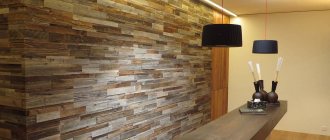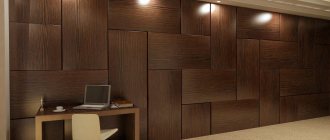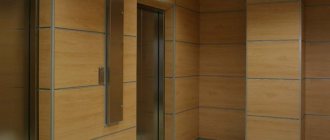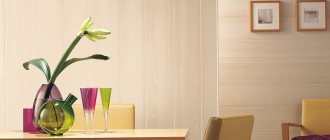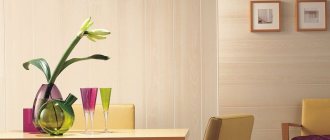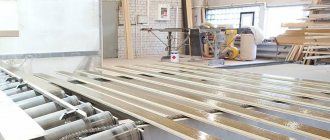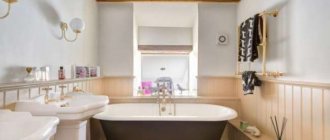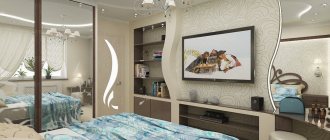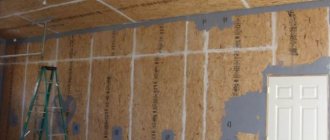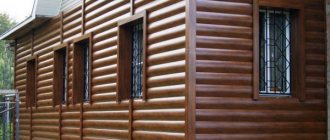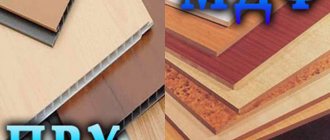Constant change of trends is inherent not only in the world of clothing, shoes and accessories, but also in interior design. More and more innovative materials are appearing, adapted to the lifestyle of modern people. But wood never goes out of style. Wooden panels for interior wall decoration are the best option for creating comfortable conditions.
Area and features of the use of wooden panels for interior wall decoration
The material fits organically into any design. It is distinguished by its uniqueness and grace. Using wood wall panels you can create a unique decorative surface. Due to the specificity of the material and its performance characteristics, the finish is suitable for indoor walls with low humidity. For rooms where this indicator is increased, special panels finished in wood look are used.
In the concept of a modern interior, they can decorate only one wall. For example, near the door, window opening, head of the bed, on balconies, provided that they are glazed.
Using wood wall panels you can create a unique decorative surface.
Ways to create simulated wood
It is impossible to use MDF, chipboard or fiberboard in their pure form, since such a finish will bear little resemblance to a wooden wall. To do this, the front side of the material is covered with a decorative layer. This allows you to achieve the texture of natural wood. There are several technologies for creating decorative surfaces:
- Veneering. This is a technique in which equipment cuts a thin layer from natural wood (veneer). Next, it is glued onto wood-look panels for interior decoration. It turns out that externally such a slab consists of 100% wood. But, this is only a thin layer that does not affect performance characteristics.
- Lamination. The decorative layer in this case is PVC film. It accurately copies the color and texture of wood, protecting the slab from moisture.
- Laminating. The option is similar to lamination, only paper is used instead of PVC film. This reduces the cost of production, however, the quality is poor.
- Painting and varnishing. Lumber is painted a certain color and then protected with varnish. It is difficult to achieve the texture of wood.
All that remains is to choose a specific option for wood-look panels for interior wall decoration, and start finishing it yourself. The process itself is simple, the main thing is to study and follow the instructions.
Advantages and disadvantages of wooden panels for wall decoration
Wooden wall panels have many more positive aspects than negative ones. The most tangible and weighty argument in their favor is the simplicity and speed of installation of the material. Plus:
- Variability of products. You can always choose the right specimen from a wide variety;
- Wide choice of palette. If desired, they can always be repainted in the desired color;
- Affordable price range. For a small cost, you can give the room a fashionable and noble look;
- Solid wood panels for walls are of high quality;
- Possibility of creating exclusive, individual models.
Ease of choice due to the many different sizes. This is a natural material, so it is perfectly breathable and does not emit toxic substances at any temperature. This decor does not require particularly careful surface preparation. In addition, behind such panels, shields or slabs you can easily hide communication systems and their components. With proper care, this finish does not lose its original appearance even over time.
This is a natural material, so it is perfectly breathable and does not emit toxic substances at any temperature.
Among the disadvantages is the reduction in the usable area of the room, provided that the installation is carried out in the classical way, which requires a solid frame.
True, there is another way - to put wooden elements on glue. This method requires a surface without drops and cracks.
Among the disadvantages is the reduction in the usable area of the room, provided that the installation is carried out in the classical way.
Exterior wood finish
Exterior decoration is the result of construction, its final touch, additional protection of the house from the influence of the external environment. Despite the wide range of new building materials that allow you to create a beautiful appearance for your home, wood wall decoration remains relevant. It combines well with other materials used in landscaping the local area.
Wood has many disadvantages. Firstly, if such material is used for finishing the facade, it must be treated with means that provide fire protection. Secondly, you will have to constantly monitor the wood and treat it with antiseptic compounds that prevent the formation of fungal colonies and mold. You can get away from this if you choose wood-like materials that do not require such careful maintenance. These include siding. This is not just a facade material, it is a whole system that consists of decorative panels and fasteners necessary for installation.
Wood-like plastic siding Source 2797921.ru
The panels themselves are made in a special way from wood fibers and polymer binders. The first ingredient is responsible for the natural texture, the second for high technical characteristics. The material does not absorb moisture, does not fade in the sun, and has high strength characteristics.
When assembled, the system provides the façade with reliable protection from rain and wind. It is not afraid of temperature fluctuations, is easy to install, and can be finished at any time of the year. If one element is damaged, it can easily be replaced with a new one without dismantling the entire wall. There is a wide variety of textures and colors on sale; the material quite skillfully imitates the surface of wood.
Today, siding is actively used both in the reconstruction of old buildings and in the finishing of new buildings. The panels are placed on the wooden cladding, overlapping. Assembled with high quality, the siding looks impeccable. But it also has its drawbacks. This is flammability and the possibility of the formation of cracks, resin pockets, knots.
Wood fiber siding Source grandline.ru
Types of wooden panels for walls
By predominant variability we mean not only a wide selection of colors, but also the type of material itself, chipboard, MDF, solid wood, OSB boards and other types.
From the array
Solid natural material is of high quality. The demand for it never falls. This material is often used for finishing offices and libraries. Mostly valuable wood species are used for their production.
Solid natural material is of high quality.
From MDF
Wooden MDF wall panels are made from dry sawdust, pressed using the dry pressing method. Such models are distinguished by high performance properties, ease of installation and maintenance. They can be installed without preliminary preparation of the walls. The panels are equally mounted vertically, horizontally and at an angle. In turn, they are divided into:
- Solid;
- Laminated;
- Glossy;
- With increased moisture resistance.
Solid elements have smooth sides on all sides. Laminated ones can be purchased with any pattern that is applied to the polymer film covering the front side. This treatment gives the product more protection against external influences.
Wooden MDF wall panels are made from dry sawdust, pressed using the dry pressing method.
Veneered
Veneered models are based on the same MDF with its advantageous characteristics. Veneer is a thin sheet of natural wood. More expensive models are made from rare wood. Products made from spruce and pine are slightly more affordable. However, the most common are models made of birch, cherry, walnut, oak, and so on.
Veneer is a thin sheet of natural wood.
OSB boards
In construction markets you can find boards called OSB or OSB. The products differ in that they are made not from sawdust, but from wood chips. Each layer is superimposed on each other perpendicularly, due to which the panels acquire sufficient elasticity and strength. OSB boards are classified where OSB -1 is the cheapest due to its low resistance, and OSB -4 is more expensive as it is resistant and can be used in wet environments.
The products differ in that they are made not from sawdust, but from wood chips.
And other possible options
There are a number of other starting materials existing on the domestic market. Wooden wall panels made of bamboo or rattan are lightweight. They are often used in extravagant interiors. 3D panels are made by hot pressing wood of different species. The result is an interesting product with a profile of a complex configuration. For their production, only rare species of wood are used.
Despite the applied 3D coating, MDF panels are not recommended for installation in areas where there is constant moisture.
Wooden wall panels made of bamboo or rattan are lightweight.
solid tree
This type is distinguished by its sophistication and is most often intended for interiors in a classic style, which gives the appearance of the interior much more solidity. They are usually made from solid wood; valuable tree species, including exotic ones, are very popular.
Finishing of such solids can be done using veneer; most often mahogany, rosewood, walnut or cherry wood, as well as other species are used for this purpose. At the same time, the decorative component also depends on what color palettes, wood shades, and various inserts that mirror each other are used. Often, colored varnishes, carved decoration, as well as the application of gilded compounds and so on are used to decorate arrays. This allows the use of massive wood boards in the decoration of the most prestigious homes.
Of course, solid wood panels for interior wall decoration cannot be used as widely as cheaper options, as they have a number of disadvantages:
- The main one of these disadvantages is sensitivity to high humidity, which is why the array cannot be installed in steam-saturated rooms. Moreover, no impregnation or specialized varnish coatings will help wood panels, since moisture still destroys the wood over time, and this effect can only be delayed.
The only way to maintain the aesthetically pleasing appearance of decorative wood is to maintain humidity at 60% at all times. If the constant rise and fall of humidity affects the finish of wood panels, sooner or later they will begin to crack and lose their appearance.
But despite the sensitivity to moisture, solid wood is quite an expensive pleasure, and the high price makes them, on the one hand, less accessible, and on the other, more prestigious.
Therefore, the most effective way to finish with wood panels is to use them in rooms with good climate control, in which pockets of pollution rarely appear and the humidity level practically does not change.
Types of wooden coverings by shape
Wall panels are practical due to the variety of shapes. Using various combinations, you can get an unusual design for a room or space. The correct size of material will help simplify the installation process. There are a number of popular elements.
Using various combinations, you can get an unusual design for a room or space.
Tiles
Wooden slabs for walls are square-shaped models. As a rule, you can find tiles in two sizes: 90 by 90 centimeters and 30 by 30 centimeters. The variety of colors allows you to create different compositions. In most cases, they are used for interior decoration due to ease of installation.
Wooden slabs for walls are square-shaped models.
Slatted panels
Elements in the form of small boards. Their maximum length does not exceed two and a half meters, and their width can vary. Like laminate lamellas, they are attached to each other using a tongue-and-groove connection. They visually expand the room.
Elements in the form of small boards.
Sheets
To save time on finishing work in large rooms, it is optimal to use sheets. Their size on average is 1 meter 22 centimeters by 2 meters and 44 centimeters.
To save time on finishing work in large rooms, it is optimal to use sheets.
And other possible options
A new product on the finishing materials market is gusvar block. This is a type of eurolining with textured relief patterns on the front side. Taking into account the functional purpose of the element, it is secured using a standard tongue-and-groove locking connection.
Depending on the dimensions of the room, as well as its stylistic direction, you can use block house, eurolining, slats, laminate, timber to decorate the walls.
This is a type of eurolining with textured relief patterns on the front side.
Types of panel wall cladding
Brick-like wall panels for interior decoration
Depending on the technology for creating the base, cladding that imitates wood texture can be divided into two groups:
- Panel finishing products with a pressed base;
This group of cladding products includes the following types of cladding:
- sheets of chipboard (chipboard), obtained by hot pressing of sawdust and shavings with a binder of formaldehyde resins;
- sheets made of fiberboard (fibreboard), obtained by hot pressing of evenly crushed wood fibers;
- Wood-effect MDF panels, made from the same wood raw materials as fiberboard, only crushed to an almost dusty consistency.
- Finishing panels with a base of polyvinyl chloride plastic (PVC), produced by extrusion.
As a finishing coating that imitates natural wood shades, manufacturers offer a wide variety of decorative options, including the effect of old wood - “real” knots, cracks, abrasions. The main types of finishing coatings for wood-based slabs are:
- applying layers of patterned paper coated with protective varnish or wax;
- film lamination;
- application of moisture-resistant acrylic-based protection;
- embossing using hot pressing followed by painting and protection;
- veneering
Each of the above types of wood-based wall cladding has its own advantages and disadvantages.
Sheathing made of DS-plates
This is the most budget-friendly type of wall cladding material. The structure of the particle board contains three layers of chips of different size fractions. The outer layers of DS-slabs are made of small chips and sawdust, the inner layer is made of large shavings. Currently, chipboard manufacturers have introduced technologies that replace toxic phenol-formaldehydes with safer synthetic binders.
The scope of application of wood-look chipboard panels is very limited (hallways and corridors) due to the following circumstances:
- narrow range of colors;
- are produced only in the form of large-sized sheets;
- heavy weight of sheet elements, complicating installation work.
In Fig. Below is shown the structure of DS boards that imitate wood texture.
Wood-look chipboard
Sheathing from DV-slabs
Fiberboard panels are the most common products used in interior finishing work. By analogy with chipboard, modern fiberboard manufacturers successfully replace formaldehyde binders with environmentally friendly resin compositions made from eucalyptus trees. To increase the waterproof properties, water repellents are introduced into the composition of the pressed mass, allowing the use of DP wall products in rooms with high humidity.
Depending on the method of preparation of wood raw materials and its pressing, DV boards are produced with a density from 150 kg/cub.m (soft boards) to 950 kg/cub.m. m (superhard slabs). Super-hard boards are used in finishing wall work. Softer materials are used for thermal insulation of walls and floors. The front side of the DV panels is laminated to match the wood grain pattern, the back side remains rough.
The advantages of wood-look DV panels include the following factors:
- water resistance;
- durability of operation;
- light weight;
- ease of machining;
- high noise, - and thermal insulation qualities.
The following disadvantages are noted:
- narrow scope of application of certain types of fiberboard;
- the toxicity of certain types of fiberboard, which requires mechanical processing of the panels in well-ventilated areas;
- It is inadmissible to use DV panels for cladding bathrooms and bathhouses.
Important! For interior wood finishing, it is necessary to choose panels from the group of super-hard slabs, since only they have high mechanical strength and environmental friendliness. The cost of super-hard DV boards offered for wall cladding is several times higher than their soft counterparts. Therefore, unscrupulous sellers easily manage to sell low-grade counterfeits at supposedly discounts, which only superficially resemble products of well-known brands.
In Fig. Below are panels made of fibreboard with a wood look. It is very difficult to distinguish imitation wood on a DV-slab from the natural texture.
LH panels with a wood pattern
Covering with MDF panels
Unlike DV boards, produced by the so-called wet pressing of steamed fine wood pulp, MDF sheets are formed using dry pressing technology. The abbreviation MDF is borrowed from the English term MDF, which denotes medium-density fiberboard (similar to fiberboard). This gives grounds to classify MDF as DW boards with an average density of 650-800 kg/sq.m. The binder is urea resins modified with melamine. They have very low formaldehyde emissions, comparable to formaldehyde emission class E1 for natural wood.
At their core, MDF panels are universal facing materials, surpassing their fiberboard counterpart in the breadth of their application. MDF panels are used to cover bedrooms, living rooms and hallways of residential buildings, offices in government agencies, rooms in country houses, etc.
To the additional advantages of MDF, one should also add the possibility of producing shaped wall panels, which are then mounted on the walls. The only disadvantage over fiberboard is the higher cost.
In Fig. Below is a wood-look paneling made from MDF panels.
Wood paneling made of MDF panels
Sheathing made of PVC panels
Wood paneling made from plastic products made on the basis of polyvinyl chloride is a complete alternative to natural wood and wood-pressed panels. Wood-effect PVC panels are very popular in the wall cladding segment due to the following advantages:
- lower cost compared to panel products made from other materials;
- high moisture resistance, allowing direct contact with water; You can even line the inside of shower stalls with PVC panels;
- universality of use in premises of any purpose;
- ease of installation and dismantling.
Among the disadvantages, the following points should be noted:
- plastic slabs do not always comply with environmental safety standards, especially when counterfeit products are used;
- weak mechanical strength, especially to accidental impacts;
- When exposed to direct sunlight, the decorative layer loses its color intensity.
In Fig. Below are shown wood-look cladding elements made from PVC panels.
Wood paneling made of PVC panels
Modern technologies for the production of panel materials for interior decoration create artificial materials that are not inferior to natural wood in aesthetic qualities and performance characteristics. However, when approaching the style and design execution for arranging a wood-like interior, it is necessary to observe a certain measure so as not to slip into excessive officialdom or vulgar tackiness. With a responsible approach to design, artistic compositions are possible that combine panel imitation wood with wallpaper, tiles and other finishing materials. The pictures below show design variations according to the “panels plus wallpaper” and “panels plus tiles” schemes.
Combination of wallpaper and panels (English style)
Combination of tiles and panels
Color range of wooden panels for walls
An abundance of colors with the possibility of repainting is an ideal option for creating individual interior projects. When choosing the color of the panels, you need to rely on the palette of the room as a whole.
When choosing the color of the panels, you need to rely on the palette of the room as a whole.
White
White is a popular color in residential areas. It is versatile and fits perfectly into any design. At the same time, a solidity of the room is created, which can be diversified with the help of bright accents.
White is a popular color in residential areas.
And other possible options
The restraint and taste of the apartment owners will be conveyed by the beige shade, which, like white, harmonizes perfectly with any interior. This also applies to gray. But with black, despite its classics, you should be careful. They can only decorate one wall.
The restraint and taste of the apartment owners will be conveyed by the beige shade, which, like white, harmonizes perfectly with any interior.
Video description
The video shows how to install fiber cement modules:
Wood-polymer panels
They have a different name; builders most often use the term “sandwich” to refer to them. Wood waste is used to make wood panels. They are mixed with polymer resins. The result is a material that looks similar to chipboard. But unlike it, it has higher resistance to biological effects.
International brands can also boast of high moisture resistance. They can be used for finishing facades in any climatic zones of Russia. Wood-polymer panels are excellent heat insulators, but they have the shortest service life (about 15 years). But they are environmentally friendly. The price per square meter starts from 480 rubles.
Wood-polymer panels for facade cladding Source deckmarket.ru
The use of wood panels for different design styles
The color scheme and texture of the material should be taken into account based on the overall concept of the interior of the room. Among the many styles, only a few stand out in interior decoration.
The color scheme and texture of the material should be taken into account based on the overall concept of the interior of the room.
Scandinavian
Northern style. It is dominated by light shades. Slat panels painted in light blue and green shades will fit perfectly. They will make the atmosphere in the house more comfortable.
In the Scandinavian style, light shades predominate.
Provence
Romantic features are characteristic of French Provence with its lavender melodies. Wooden panels for light-colored walls fit here. Shades of gray, blue and green predominate.
Romantic features are characteristic of French Provence with its lavender melodies.
Loft
An ultra-modern direction of interior design, which welcomes a certain “roughness” and the use of elements bestowed by nature itself. In it, like in no other interior, panels of a natural shade would be appropriate.
In a loft style, panels of a natural shade would be appropriate as in any other interior.
And other possible options
The use of wood is relevant for the classical style, as well as modern. To decorate a room, it is better to use light colors, and it is advisable to install dark-colored boards closer to the floor, creating contrast.
The use of wood is relevant for the classical style, as well as modern.
Tips for choosing panels
- Light shades are best for children's rooms and bedrooms. The texture imitating light oak and ash looks good.
- Living rooms and offices are lined with dark colors. This creates an atmosphere of comfort and well-being.
- Textured elements are installed in the bathroom, which are combined with other materials.
Wood-effect panels are very diverse and can be used to decorate any room in a house or apartment.
Wood-effect wall panels are an excellent option for those people who prefer classics and natural motifs, but are not willing to overpay for the purchase of natural wood products.
Methods for installing wooden panels on walls
There are several options for covering walls with panels. When choosing an installation method, you must remember that slabs or beams are not only a decorative element, but are also capable of hiding defects and some components of communication systems. Place the panels on glue. To do this, the rough version of the walls must be perfect. If there are differences of more than half a centimeter, you need to carefully putty and level the walls. The adhesive solution is applied with a relief spatula to the surface.
If glue gets on the front surface of the material, it is immediately removed.
The panels can be secured with brackets that are attached to the rough surface using the previously made markings. The brackets are fixed with self-tapping screws according to the markings. The first panel is always mounted in the corner of the wall. For large wooden slabs and panels, it is better to use profiles. This is the most labor-intensive method. In addition, mounting profiles slightly conceals the usable area of the room. Fixing wooden panels to the wall begins from the corner of the surface, as in previous cases.
Fixing wooden panels to the wall starts from the corner of the surface.
Taking into account the large selection of raw materials in construction markets, it is possible to create unique chic and comfort for people of any income. When choosing wooden panels, the quality of the coating, the size of the room and the stylistic direction are taken into account.
Installation technology
Wood-look wall panels are mounted in two main ways: frame and glue. Each of them has its own characteristics. But the surface is first prepared.
Working with the surface
In principle, the event is standard for all types of finishing work. The following steps must be completed:
- The old layer is deleted. Cleaning is carried out down to the base or plaster.
- The strength of the coating is assessed. The presence of crumbling areas is unacceptable.
- Cracks and chips are covered up. The walls are primed.
Removing the old layer is one of the mandatory stages in preparing walls for installation of wall panels
.
Products are best laid on a wooden frame. It allows you to obtain a reliable design. If there are significant distortions, then metal profiles are used, which are fixed to hangers.
So the procedure is:
- Markings are applied to the surface, which depend on the chosen cladding scheme.
- The wooden beam is marked in increments of 35-45 cm. Drilling is carried out along the given marks, which is necessary for fastening to the wall.
- The markings are transferred to the marked lines. Places for installing dowels are drilled out.
- The racks are secured with screws. A level check is carried out.
- If necessary, scraps of boards are placed under the timber to smooth out minor unevenness.
The construction of the frame allows you to obtain a durable structure for laying panels
.
The panels are laid on the frame using the following technology (regardless of the layout):
- The cladding starts from the inner corner.
- If required, the protruding part is cut off to fit into the groove.
- The first fragment is secured using self-tapping screws.
- Fastening to the sheathing is carried out through special brackets (clasps). If such devices are not available, you can attach them directly to nails (screws), which are driven into the inside of the groove.
- Subsequent fragments are grooved and fastened according to the chosen pattern.
Installation with glue is performed a little differently:
- It is necessary to carefully prepare the surface; it must be perfectly flat.
- Glue is applied to the panel, which is distributed along the contour of the part and the center.
- The fragment is laid and pressed. It should be understood that any inaccuracies are corrected immediately.
- Next, subsequent elements are laid out.
Purchasing wood panels
Before buying wooden panels for wall decoration, you need to take scrupulous measurements and calculate the required amount of material and fasteners, based on the following data:
- Initially, it is necessary to calculate the amount of cladding based on the area of the surfaces to be finished. To do this, measure the length of the treated surface, which is divided by the width of the strip of the decorative element. The length of the panel must be selected based on the height of the room being repaired or the surface to be finished.
- During the calculation process, it is necessary to take into account the openings of doors, windows, arches and other architectural elements used in the room. After which you can make the necessary adjustments to the amount of material and fasteners calculated from the total surface area for cladding.
- The calculation of components for hiding joints and edges will depend on the number and size of openings, as well as the number of internal and external corners of the room and installation options.
It is important to be as careful as possible when purchasing a kit for fastening wooden wall panels, checking every little detail so that during repairs you do not have to run to the store to buy the missing parts.
Cost of wood panels
If we talk about the cost of this type of cladding, the price range is quite wide. So, if we take oak panels as an example, then this material is the most expensive and its price reaches 200 evergreen dollars per square meter. Naturally, no one is forcing you to purchase oak cladding; there are many other cheaper alternatives, for example, the cost per square meter of such mahogany cladding is half the price of its previous oak counterpart. However, regardless of the choice of material, before purchasing it directly, it is necessary to take into account the costs of corner and docking posts, as well as other consumables.
